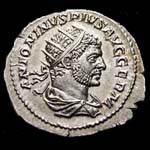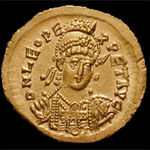 |
 |
 |
Republic |
Empire |
Byzantium |
Roman coins began to circulate only in the second phase of the Republic. In the initial period of the history of Rome, from its foundation (25 April 753 B.C.) to the end of the monarchic period (753-509 B.C.) and part of the republican period (509-31 B.C.), as medium of exchange in alternative to the barter was used bronze blocks melted in irregular form and with variable dimensions, with a value given by the weight of the metal metal which it is built (aes rude). Of course, the main drawback of this kind of payment was related to the need to weigh the amount of bronze to use in each exchange.
Presumably due to the initiative of merchants followed by the government, ingots in bronze of regular form began to be used, usually in rectangular shape, carrying marks able to identify its manufacturer (aes signatum). Also in this case, however, the lack of uniformity in weight (and therefore in value) of these objects, don't allow to consider them as coins.
In the Republican age, the first Roman coins was the as (aes grave or aes librale), introduced at the beginning of the sea trades in 335 B.C.. In this phase the as was made by casting, rather than striking. At the beginning, its weight was equal to a Latin pound (273 g), then becoming equal to a Roman pound (327g).
The value of the as was progressively reduced, acquiring the value of its fractions, with 1/2 Roman pound in the 286 B.C., 1/6 of pound in the 268 B.C., 1 ounce (that is 1/12 of pound) in the 217 B.C. and 1/2 ounce in the 89 B.C..
Around the 300 B.C. the Romans come in contact with the Greek civilization in South Italy. In the relationships with the cities of the Magna Graecia, where they began to use Greek-style silver coins, as the bronze coins had an insufficient value for the commercial trades.
The first silver Roman coin was the didrachm. This coin, minted following the Greek monetary system, was minted in Capua in 312 B.C. with a weight of 6,82 g. The didrachm was replaced at the beginning of the 221 B.C. by another silver coin, the victoriatus, which had, however, limited circulation.
The Roman silver coin which constituted the skeleton of the economy in Rome was the denarius, coined since 268 B.C.. Its initial value was of 10 asses, equal to 1/72 of pound (4,55 gs). In the 217 B.C. the denarius was revalued to 16 asses, following the reduction of the value of the last one. Even if the denarius remained the basic element of the Roman economy, since its introduction up to the end of its minting in the half of the III century A.C., the weight of the coin and the percentage of silver contained in it was progressively reduced. The depreciation of the Roman coinage, a constant phenomenon since the end of the Republic and through the whole empire, was caused by several factors, like the lack of precious metal, the relaxation in the public finances and the presence of a strong inflation.
The minting of gold Roman coins began after the conquest of the Gallia from Julius Caesar, due to the availability of gold metal in its mines. The first issue of a gold coin was with some staters in 286 B.C., with a weight of 6,81g, followed by a series in the 209 B.C., with a weight of 3,41 g. The first aureus of the Roman monetary system were minted in 87 B.C. from Sulla, with a value of 1/30 of pound equal to 9,11 g., followed by an issue from Pompey in the 61 B.C., with a value of 1/36 of pound equal to 9,06 g. In 48 B.C. the minting of aureus from Caesar began, starting with a value of 1/38 of pound (8,55 g) and then (always in the 48 B.C.) with a value of 1/40 of pound (8,02 g).
The first main monetary reform of the imperial age was the reform of Augustus in 15 B.C., which gave to the emperor the control of the the minting of the coins in gold and silver, while the senate could take care of the minting of the coins with a lower worth. In fact, the mintage of the Roman coins in bronze, used by the people for the day-by-day needs, was granted to several authorities of the Roman Provinces, as they were of small importance for Rome, but it didn't happen for the coins in other metals, used to pay the expenses of the state, being the last one of considerable entity, so they could not be paid only with coins in precious metal. In the reform, the aureus was confirmed as gold coin (1/42 of Roman pound, 7,78 g) as the denarius remained for the silver coins (1/84 of pound, 3,90 g). The as in copper was adopted for the smaller values (10,90 g), with its multiples in orichalcum (a metal similar to the brass) called dupondius (2 asses) and sestertius (4 asses); the fraction was the quadrans, a coin in copper (1/4 of as).
During the Julio-Claudian dynasty (Tiberio, Caligola, Claudio, Nerone) the value of the denarius was relatively stable. In the 65 AD Nero introduced a new monetary reform: the aureus was worth to 1/45 of pound (7,28 g), while the denarius was worth to 1/96 of pound (3,41 gs). At the end of the Flavian dynasty (Vespasiano, Tito, Domiziano), Domiziano annulled the reform of Nerone, bringing back the Roman coins to the values of the reform of August, while in the period of the adoptive emperors (Nerva, Traiano, Adriano, Antonino Pio, Mark Aurelio), Traiano adopted again the system of the reform of Nero.
In 215 the emperor Caracalla introduced another monetary reform. In fact, the denarius continued its decline during the whole empire of Commodo and Settimio Severo. With Caracalla the aureus was devalued again, bringing it to 1/50 of pound (6,54 gs). Besides, both for the aureus and for the denarius (reduced to have less than the 50% of silver) coins were introduced with a doubled value: the double aureus (or binio) and the double denarius (or antoninianus), even if the antoninianus didn't contain more them 1,6 times the silver content in a denarius. However, while the aureus had a stable value, the antoninianus knew the same progressive devaluation already had with the denarius, having at the end only a 2% in silver content.
Between 272 and 275, Aurelian reformed again the Roman monetary system, revoking the authority of the local mints to produce small coins, to bring them to the qualitative level of the other coins. The value of the aureus was initially fixed to 1/60 of pound (5,54 gs), but then it became 1/50 of pound (6,50 g). The antoninianus had a weight of 3,90 g and a title of 20 parts of copper and one of silver, with such ratio displayed on the coins by means the symbol XXI in Latin or KA in Greek.
The Roman coinage changed radically with the reform of Diocletian. As the government introduced by Diocletian was founded on a tetrarchy, with the subdivision of the empire in two territories assigned to two different emperors and with two Caesars as support to the two regents, the coins began to no more represent a single regent, giving an idealized image of the emperor, with the reverse typically celebrating the glory of Rome and its military power. Also after the adoption of the Christianity as religion of state, this approach remained quite unchanged: in the Byzantine coins, Christian images were used only in few exceptions like the chi-rho, a Greek monogram for the name Jesus Christ. In 300 an edict was emanated with the maximum prices of commodities to control their price: the prices were expressed in denarii, even if it was no more a circulated coins. The aureus returned to a weight of 1/60 of pound. A coin in silver was introduced, called argenteus, with a weight equal to 1/96 of pound. In addition to an antoninianus with a weight of 3,90 g, a coin in bronze was introduced too, the follis, with a weight of around 10 g.
Last reform of the Roman empire was in 310 the one of Constantine, who restored the bimetallic system of Augustus. The gold coin named solidus was introduced, with a weight of 4,54 g corresponding to 1/72 of pound, and the silver coin named siliqua, of 2,27 g corresponding to 1/144 of pound; the miliarensis, with a value double of the siliqua, had therefore the same weight of the solidus. Concerning the bronzes, the follis, strongly devalued, was replaced by a coin of 3 g called nummus centonionalis, corresponding to 1/100 of the value of the siliqua.
This monetary system had a correction for the coins in copper in 346 with the emperors Constantius II and Constans (in Eastern and Western Empire), with the minting of the maiorina which replaced the nummus, halved in value (around 1,35 grams).
This monetary system lasted up to the end of the Western Roman Empire. Concerning the Eastern Roman Empire, in 498 the Anastasio's monetary reform took place, based on multiple of the nummus for the coins in bronze and the solidus for the coins in gold.